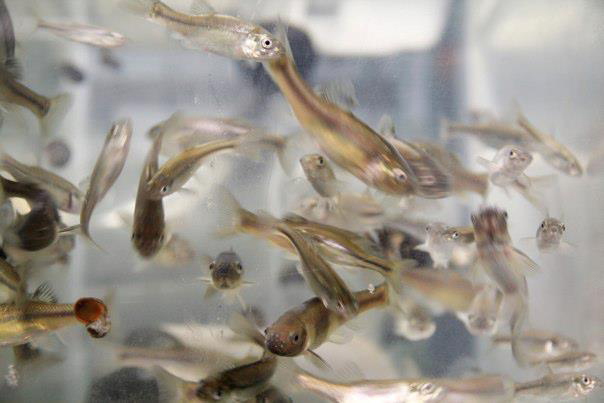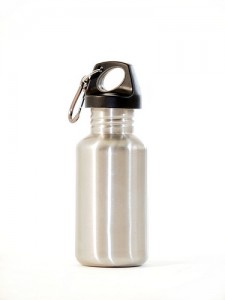
The fathead minnow is a dull, common bait fish, but it has become an important species for research on endocrine disruptors. Here, fish are being raised for research at a U.S. Environmental Protection Agency laboratory in Duluth, Minn. Photo: Kate Golden, Wisconsin Center for Investigative Journalism
By Kate Golden
Wisconsin Center for Investigative Journalism
Advice from experts.
- To limit BPA exposure, be careful with plastics used with food. Heat food in glassware and carry stainless steel bottles. Discard scratched plastic, and don’t buy used plastic containers. Consider eating less canned food, since can liners may contain BPA. Link: the government’s advice on BPA.
- Check the Environmental Working Group’s Skin Deep cosmetics database, which notes when products contain chemicals associated with endocrine disruption, and its 2012 shopper’s guide to pesticides in produce. Apples top the “Dirty Dozen,” while sweet corn ranks in the “Clean 15” – 98 percent of samples contained no detectable pesticides.
- Don’t flush pharmaceuticals; look for take-back programs in your community. Drugs often pass through wastewater treatment plants and end up in Wisconsin’s waters. The Wisconsin Department of Natural Resources estimates that just 2 percent of the drugs in Wisconsin are properly collected.

Using re-usable water bottles is a good way to help the environment, but invest in one made of stainless steel rather than polycarbonate plastic – toxicology reports indicate plastic bottles may contain bisphenol A, or BPA. Photo: Ned Yeung, Flickr
What’s in my drinking water?
Experts interviewed did not advise that people should stop drinking their water or swimming in lakes because of general concerns about endocrine disruptors.
Public systems: Explore the New York Times’ Toxic Waters database from 2009 for contaminants that have been found in public water systems – some of which may be endocrine disruptors, like the pesticide atrazine. For more recent information, call your local water utility.
Private wells: Use the Wisconsin Well Water Viewer to explore what pollution has been found down to the section level. Also from the Center for Watershed Science and Education at the University of Wisconsin-Stevens Point: a Q&A for private well owners, which includes links to water testing resources.
Learn more
– National Resources Defense Council fact sheet on endocrine disruptors
– Collaborative Health and the Environment fact sheet on endocrine disruptors and women’s health from 2008
– e.hormone Comprehensive endocrine disruption tutorials and links from Tulane University
– Q&A for families on endocrine disruptors From the Emory University Pediatric Environmental Health Specialty Unit
– U.S. Health and Human Services Q&A about soy infant formula
– The Endocrine Disruption Exchange
– The impact of endocrine disruption: Consensus statement on the state of the science April 2013
– EPA’s Endocrine Disruptor Screening Program
– Chemical Fallout The Milwaukee Journal Sentinel’s award-winning series on the risks posed by BPA
This story is part of a project supported by the Fund for Investigative Journalism and the Fund for Environmental Journalism. The nonprofit Wisconsin Center for Investigative Journalism collaborates with Wisconsin Public Radio, Wisconsin Public Television, other news media and the UW-Madison School of Journalism and Mass Communication.
All works created, published, posted or disseminated by the Center do not necessarily reflect the views or opinions of UW-Madison or any of its affiliates.
Related stories:
- Profiles of chemicals in the water
- Tainted fish: Chemicals trigger consumption warnings
- Minnow reveals wastewater’s toxic effects
- Full series at Water Watch Wisconsin
Also on Echo:
- Can drugs prompt Great Lakes fish feeding frenzy?
- Pharmaceuticals difficult to treat in drinking water
- Michigan officials look to stop pharmaceuticals from getting into water
- Pharmaceutical compounds contaminate the Great Lakes
- Dangerous fragrances
- Fish sharing male, female characteristics raise concerns about Great Lakes contaminants
- St. Lawrence River PCBs linked to low testosterone
Pingback: Endocrine disrupters: What can I do? | Environmental News Bits